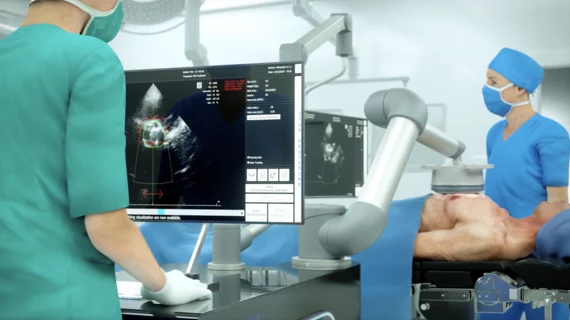Cardiawave’s non-invasive ultrasound therapy impresses cardiologists early on—could it be an alternative to SAVR, TAVR?
Non-invasive ultrasound therapy (NIUT) could be a safe, feasible treatment option for patients with severe symptomatic aortic stenosis who are ineligible for surgical or transcatheter valve replacement, according to early findings published in The Lancet.[1]
While transcatheter aortic valve replacement (TAVR) and surgical aortic valve replacement (SAVR) remain the go-to treatments for severe AS, the study’s authors explained, some patients are not considered for those procedures due to severe comorbidities or a limited life expectancy.
This is where the Valvosoft device from Cardiawave SA, a French healthcare technology company founded back in 2014, enters the equation. Valvosoft uses NIUT to target the leaflets of the aortic valve using “precise and focused ultrasound pulses.”
“The device acts on embedded calcifications and produces tissue softening through dense energetic cavitary bubble clouds generated by short ultrasound pulses of very high pressure,” wrote first author Emmanuel Messas, MD, PhD, a cardiologist with Hôpital Georges Pompidou AP-HP in France, and colleagues. “By softening the calcified valve tissues, NIUT helps restore leaflet mobility and might improve the overall clinical status of patients with calcified aortic stenosis.”
Messas et al. performed a first-in-human study focused on 40 adult patients with severe symptomatic aortic valve stenosis treated with the Valvosoft device. Patients underwent treatment from March 2019 to May 2022 in France, the Netherlands or Serbia. The mean patient age was 83.5 years old. The mean Society of Thoracic Surgeons score was 5.6%. Severe comorbidities such as coronary artery disease (45%) and congestive heart failure (30%) were seen in a significant percentage of patients.
Clinical and imaging-based follow-up assessments will occur after one month, three months, six months, 12 months and 24 months; this specific analysis includes data from the study’s first six months.
Treatment with NIUT lasts a maximum of one hour, with operators typically choosing to break it up into six 10-minute sessions.
“This procedure is strictly non-invasive and is usually well tolerated,” the authors wrote. “The patients were placed either in the supine or left lateral decubitus position, whichever was best for transthoracic imaging. Periprocedural monitoring was ensured using continuous electrocardiography, intermittent brachial blood pressure, and peripheral arterial oxygen saturation. Pain medications were permitted, combined with mild sedation, if necessary.”
Overall, the study’s primary safety endpoint—procedure-related deaths after 30 days—was seen in no patients. No procedure-related life-threatening or cerebrovascular adverse events were reported. One patient was excluded from the study early because they ultimately underwent TAVR. Meanwhile, three patients underwent an additional NIUT session with the same device within the first six months of treatment.
Researchers also tracked valve function, noting that the mean aortic valve area (AVA) increased by 10% and the mean pressure gradient decreased by 7% after six months. Treatment was also linked to improved or stabilized New York Heart Association scores in 96% of patients and consistent improvements in quality of life as measured by Kansas City Cardiomyopathy Questionnaire score.
In addition, the group noted, the two patients included in the study who presented with bicuspid valves also saw improvements in both AVA and mean pressure gradient.
Reviewing these early findings, Messas and colleagues found that NIUT with the Valvosoft device appears to be “feasible and safe,” providing “some hemodynamic and clinical improvement” among high-risk patients with severe symptomatic aortic stenosis.
“The fact that no stroke was clinically observed is highly reassuring regarding the safety of the Valvosoft device and procedure,” the authors wrote. “The absence of any new cerebral lesions detected in the subgroup of ten patients who underwent systematic preprocedural and postprocedural brain MRI supports this assertion. Additionally, no decline in the cognitive function of the patients occurred during follow-up, as reflected by the lack of change in their Mini-Mental State Examination scores. Notably, the three patients who underwent more than one Valvosoft procedure were all alive and free of serious adverse events at 6 months.”
Cardiawave did fund this early analysis. Additional updates on this research are expected as more time passes.
Click here for the full study.
NIUT with the Valvosoft device a potential ‘medical breakthrough’
Cardiawave issued a prepared statement highlighting these early results.
“Clinically, the patients experienced a considerable improvement in their clinical status, suggesting a better quality of life,” interventional cardiologist Roxana Mehran, MD, PhD, director of interventional cardiovascular research and clinical trials with the Zena and Michael A. Wiener Cardiovascular Institute at Mount Sinai and part of Cardiawave’s scientific advisory board, said in the statement. “These early findings can represent a change in the paradigm of calcific aortic stenosis (CAS) treatment, especially for patients who have no other options. I am encouraged by the momentum of these study results as I anticipate that this therapy potentially brings a new medical breakthrough to many patients suffering from CAS in the world.”
Cardiawave also announced that a total of 100 patients have now been treated with the Valvosoft device at a total of 12 facilities in four countries.

